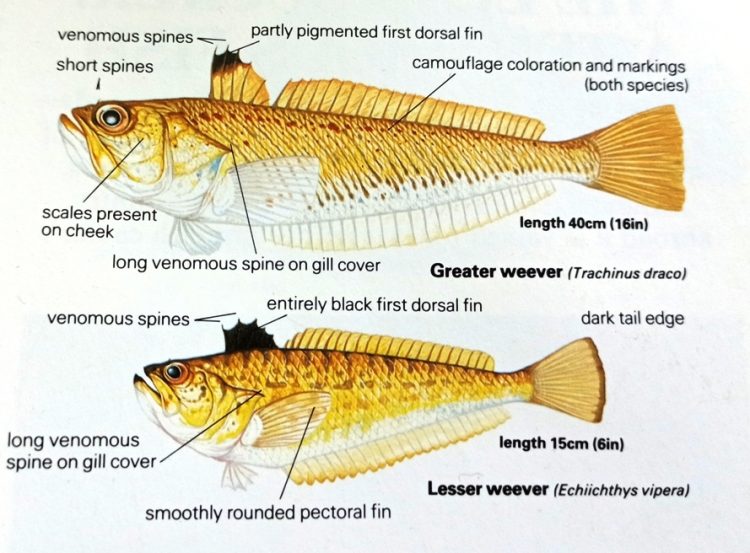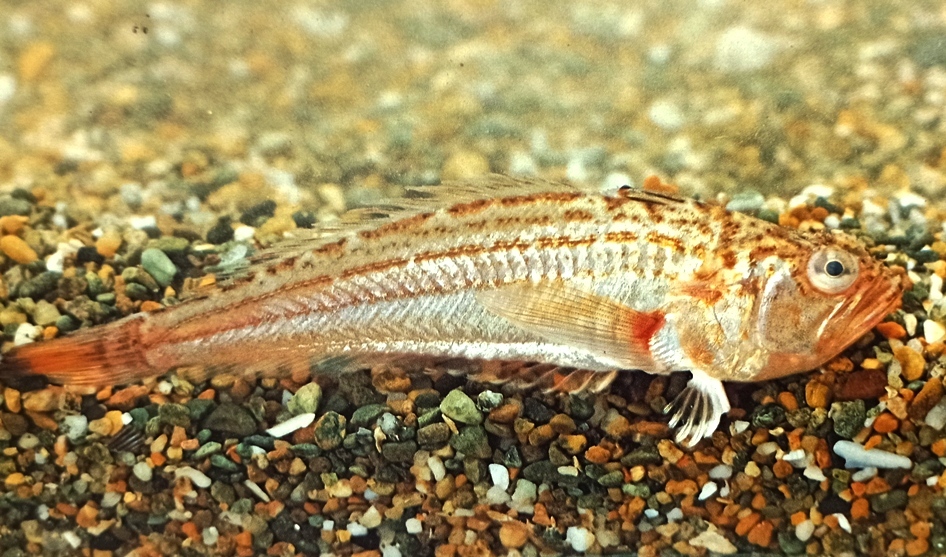Although the vast majority of Weever Fish throughout the world are harmless to man! There is a sizeable number with deadly stings, poisonous flesh, or the ability to give hefty electrical shocks. The weever fishes are among the few species dangerous to a man in British waters, for they have painful stings.
The venomous nature of the weever fish is reflected in its common name, which comes from an Anglo-Saxon word meaning a viper. Two species of weever are found in British waters, the greater weever (Trachinus draco) which can reach 40 cm (16in) in length. The more commonly reported lesser weever (Echiichthys vipera) which only grows to about 15 cm (6in) in length.
Weever Fishes occur all-around British coasts, but only in sandy areas, and their distribution is patchy. Encounters with the greater weever are less likely because it prefers deep water from about 30 to 100 m (15-50 fathoms). The lesser weever lives in relatively shallow water down to about 50 m (25 fathoms) and also occurs intertidal. It moves in and out with the tide and occasionally remains on the shore buried in the sand or in pools.
Recognition Features
Weevers are easily recognized by their deep body and head, with the mouth pointing upwards in a strongly oblique position and the eyes almost on top of the head. On the back near to the head is a distinctive small spiny fin. This is the first of the two dorsal fins, and the spines that protrude from it have venom glands. The gill covers are also armed with smaller venomous spines.
In the lesser weever, this first dorsal fin is entirely black, whereas in the greater weever the fin is only partly pigmented. Weevers are difficult to spot underwater, or even in an aquarium, because apart from the camouflage provided by their yellow-brown sandy color, they spend much of their time partially buried in the sand, often with only the eyes and the treacherous first dorsal fin showing.
The Sting and the Remedy
It is the habit of lying buried in the sand that makes the lesser weever, in particular, a danger to bathers and baits diggers on sandy beaches, and to unwary skin divers. The black first dorsal fin is folded back at rest, but at the approach of any intruder-such as a diver or the foot of an unwary paddler-the fin is erected ready to sting.
At times a great many of these fishes are caught in shrimp fishermen’s nets since the shrimps also live in shallow sandy areas, and the fishermen may be stung when handling their catch. Although the sting is intensely painful and may be serious if shock or secondary infections set in, it is not directly fatal. The wound causes local and often considerable swelling of the affected limb and can also result in fainting, palpitations, fever, delirium, vomiting and respiratory distress.
Obviously, the effects are most likely to be serious if the victim has a weak heart or is a small child. No fatalities have been recorded in this country, though there is obviously a danger of drowning if a bather or diver is incapacitated by the sting. The pain and other symptoms usually subside within about 12 hours, which gives credence to the old belief among fishermen that the effects would last until the tide returned to the same height as it stood when the injury occurred!
The most widely recommended remedy for weever stings is to soak the affected area in very hot water as soon as possible. The heat destroys the toxic quality of the venom. It is as well to know this since many doctors and even hospital casualty wards do not even realize that there is such a thing as a venomous fish in Britain and are not familiar with this remedy.
For Defense Only
The function of the venomous sting appears to be entirely defensive and protects the weever from attack by would-be predators. A bee sting is similarly defensive, whereas, in contrast, a snake uses its venomous bite to capture its prey. When erected, the black color of the dorsal fin of the weever shows up against the pale sandy background and may serve as a warning.
The sole (Solea solea) has a black pectoral fin which, if held up when the fish is lying on the bottom, is said to resemble the venomous weever fin. In this way the sole may be a mimic of the weever, frightening off predators; but this has not been proved. Weevers feed mainly on small bottom-living animals such as amphipods (sandhoppers), brown shrimps, small crabs, sand eels, gobies, and worms.
They are active mainly at night, but in daylight they can use their camouflaged position in the sand, lying in wait to pounce on passing prey. Lunging movements can bring the fish to the prey so that the upwardly directed mouth can make short work of the victim.
Spawning and life History
Although considerable research work has been done on the underneath on the venom and stinging apparatus of weever fishes! Hence, there is very little is known about their general biology. Both species spawn in summer between June and August, and some observations suggest that the greater weever may migrate inshore to spawn. The eggs are 1-1.5 mm in diameter, and those of the greater weever, though a larger fish, are the smaller.
A lesser weever fish with its venomous-spined fin lowered. The species is widely distributed around our coasts, though fortunately for us, it is only locally common. It appears to be less numerous in Scotland and on the west coast of Ireland. At times or in areas where local knowledge recommends the fish may be a danger, the simple precaution of wearing shoes when paddling or swimming should help prevent stings.

The Weever’s Defense
The weever tries to make it as inconspicuous as possible in order to surprise its prey. It is not an aggressive fish, and normally predators are warned off by the black coloring of the fin.

Venomous fishes
The venom produced by the weever is a complex substance that includes a chemical called hydroxyl-tryptamine. This is a nerve poison and is one of the most potent pain-producing substances known. The venom is produced by the glands at the base of the dorsal fin spines, and when the cells of these glands are ruptured the fluid runs along grooves in the spines and into the victim.
The gill covers are also armed with venomous spines. Other venomous spined fishes occurring in British waters (though deeper than the lesser weever) are the spurdog (which is a small shark) and the stingrays.

Identifying Weever Fish
It is worthwhile learning to recognize the weever fishes and the symptoms that their stings produce so that victims can be quickly helped and reassured. The greater weever, being a fish of deeper water, is likely to be a problem only for fishermen. On the Continent, it is sold for food after the removal of the venomous spines. Apparently, it is extremely palatable.

Read More – The Mythical Looking Pink Dolphin
Product You May Interested
- Feel Emotional Freedom! Release Stress, Heal Your Heart, Master Your Mind
- 28 Day Keto Challenge
- Get Your Customs Keto Diet Plan
- A fascinating approach to wipe out anxiety disorders and cure in just weeks, to become Anxiety free, relaxed and happy.
- Flavor Pairing Ritual Supercharges Women’s Metabolisms
- The best Keto Diet Program
- Boost Your Energy, Immune System, Sexual Function, Strength & Athletic Performance
- Find Luxury & Designer Goods, Handbags & Clothes at or Below Wholesale
- Unlock your Hip Flexors, Gives you More Strength, Better Health and All-Day Energy.
- Cat Spraying No More – How to Stop Your Cat from Peeing Outside the Litter Box – Permanently.







